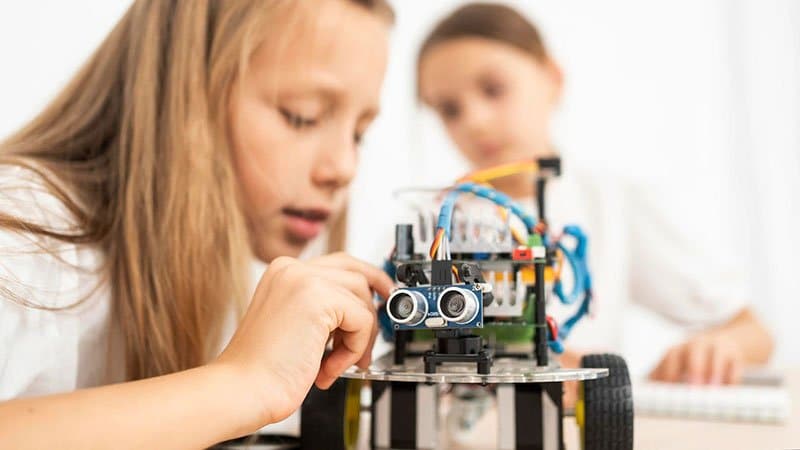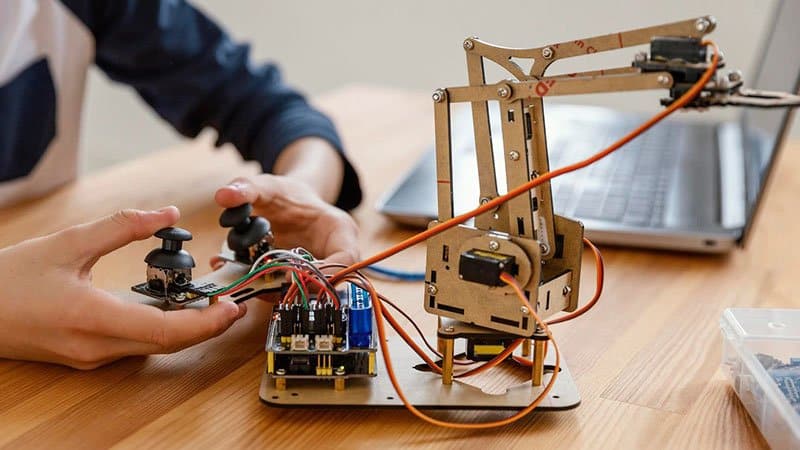Robotics is becoming an increasingly important part of the educational experience. From elementary classrooms to university classrooms, robots are providing new and immersive learning experiences for students of all ages. Robotics has the potential to revolutionize the way we teach, allowing us to move beyond the traditional learning model. This guide will provide an overview of the various ways robotics can enhance classroom learning, from increasing student engagement to delving deeper into complex topics. We will delve into the advantages of using robotics in education, discuss potential pitfalls and challenges, and provide a comprehensive overview of the current state of robotics in classrooms. By the end of this guide, you should have a clear idea of how robotics can be used to enhance the educational experiences of students of all ages. Take a look at our Coding and Robotics Course for Teachers and learn all about it with Plus Project!

Introducing robotics in education
Given the growing importance of STEM fields in society, it is no wonder that educators are exploring ways to improve access to these subjects and increase student engagement. Robotics is an excellent tool for both. Students can explore complex topics in a hands-on, immersive way that fosters creative thinking, critical thinking and collaboration. Robotics also allows students to develop important 21st century skills such as critical thinking, collaboration and problem solving, all while having fun! The use of robotics in education will only grow as technology becomes more advanced, cheaper and easier to use. Robotics offers students a hands-on, immersive way to learn about topics that would otherwise be difficult to explore in the classroom.
Advantages of robotics in education
Robotics can be used to teach almost any subject in any field of study. Robotics offers students a hands-on, immersive way to explore difficult topics, such as physics, biology, and computer science. Students can develop important 21st century skills, such as critical thinking, collaboration, and problem solving, while exploring these complex topics. Robotics has the potential to revolutionize the way we teach both STEM fields and other subjects, providing a new and exciting way to engage students.
Challenges of robotics in education
There are many challenges facing educators as they incorporate robotics into the classroom. Some of these challenges are simply growing pains and will be resolved as the robotics industry continues to develop. Others are inherent to the technology and will require continued investment to overcome. One of the biggest challenges facing educators is the lack of access to robotics. While many schools have robotics programs, many lack the funding to provide every student with a robotics kit. Another major challenge is the time required for robotics. Robotics uses complex, time-consuming equipment that can be difficult to incorporate into classrooms.
Types of robotics used in education

There are three common types of robotics used in education. Programmable robotics are autonomous machines controlled by a computer program. Teleoperated robotics are remotely controlled by an operator using a controller. Hybrid robotics are a combination of autonomous and teleoperated robotics. Programmable and teleoperated robotics are the most common types of robotics in education. Hybrid robotics is less common, but is growing in popularity.
Robotics in primary and secondary education
Robotics is commonly used in primary and secondary education to teach complex subjects. One of these is computer science. The use of robotics in teaching computer science allows students to experience the concepts behind coding while exploring a practical topic. Robotics can be used to explore scientific concepts such as physics, biology, and chemistry. Robotics is often used to explore complex topics such as the solar system, genetics, or the water cycle. Robotics is used for a variety of purposes in early childhood education. It is often used to encourage creative play, develop motor skills and teach important concepts.
Current status of robotics in education
Robotics is increasingly present in educational environments. Robotics is often used in early childhood education, primary education and, in some cases, secondary education. Robotics is used in a variety of fields, from biology to chemistry.
Tips for incorporating robotics into the classroom
There are many ways to incorporate robotics into the classroom. The most important is to make sure you have a clear learning objective and that the robotics program supports that objective. You can also incorporate robotics into subjects outside of STEM fields.
Robotics can revolutionize the way we teach. It provides students with a hands-on, immersive way to explore difficult topics and develop important 21st century skills. While robotics has a long way to go before it can be incorporated into every classroom, it is clear that it is here to stay. The only question is how we will use it to improve and transform education.

We at Plus Project are passionate about transforming the adult education landscape. As a premier training provider, we take pride in offering top-notch courses for teachers, aimed at sharpening their skills and expanding their knowledge. Our expert trainers use cutting-edge methods to deliver a dynamic and engaging learning experience, making us the ideal choice for teachers seeking professional growth and success. Join us on our mission to elevate the teaching profession, one course at a time.


